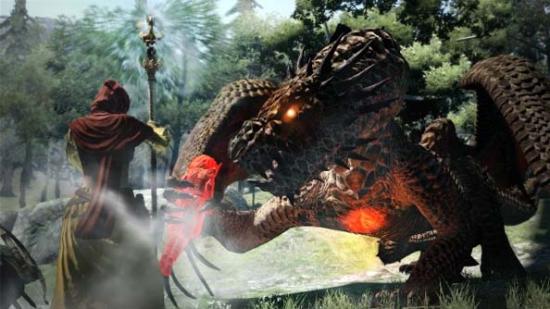Capcom’s strange and wonderful RPG Dragon’s Dogma: Dark Arisen is out on PC this very day – and from over in last-gen console land, the PS3 and Xbox 360 versions are exchanging baleful glances and feeling pretty bad about themselves. PC producer Jon Airhart spoke to PCGamesN about the process of migrating the game to a new and let’s face it, better, platform, and revealed that the game’s ‘high’ draw distance setting extends the horizons three times further than in the original console release.
Heart started racing when you read ‘Dragons’ huh? You’ll like our best PC RPGs feature.
“We have low, medium and high distance settings in the game,” Airhart tells us. “Low is the same draw distance as the console versions, medium is roughly twice the console distance, and high is roughly three times the console distance.
“We were able to push the distance out quite a bit! We also have made strides to increase the number of objects visible such as interactables, enemy NPCs and so on.”
Airhart isn’t able to give us a similarly specific figure about the LOD in a given scene though, because the nature of the game means there’s a huge amount of environmental variation in both interior and exterior spaces: “It’s hard to be specific about exactly how much the number of objects increased because that’s highly dependent on the level design.” The Bitterblack Isle’s a pretty big place, after all.
It’s clear the game’s had a lot of work done to it, under the proverbial bonnet, since 2012. The intention on Capcom’s part clearly isn’t just to send a role-playing curio out into the wild, cold and shivering, but to bridge the gap between the graphical standards of then and now.
“The biggest challenges included adding modern graphics effects such as hardware-optimized HDR,” says Airhart, “ambient occlusion, and other effects into a game whose assets weren’t built with those bells and whistles in mind. Balancing the final look of these new effects took quite a bit of tuning. Also, we had to make sure that the online portion of the game was fully ported over to Steam.”
A particular difficulty in porting the online component is the Pawn system, whereby players create their own companions who learn from quests and get smarter as they’re used more, then share those companions with the rest of the community. If you can find a shrine, you can download someone else’s Pawn into your game and have them offer handy tips on how to beat a particular boss.
Airhart tells us that while the online code has been reworked for Steamworks, “the actual server code itself is identical to what’s on console, and that was all written in Japan” by the game’s original developers. At one point the PC team in the US thought they’d unearthed a glitch when one of their testers discovered that their Pawn kept bringing back rocks rather than items. Not so: “Our Japan team confirmed that his in-development Pawn was being recognized as a hacked Pawn, so the items all turned to rocks, which is exactly how the server is intended to function.” The moral: say no to hacked Pawn.
The texture assets Airhart and his team used to build the PC version qare the original, uncompressed texture assets created for the 2012 release. Is it common practice then to keep hold of those assets for years after a game hits the shelves on its originally intended platforms?
“It is indeed!” says Airhart. “These source assets become part of the ‘game works archive’, which is like of like the ‘gold master’ recording of a song. For just about any modern game, assets are created at a higher quality than what appears in the final game.
“Then, as the memory and performance budgets become clear and the game is optimized, the assets are run through a pipeline that is designed to retain as much of the source quality as possible while ensuring great performance on the target platform. When we have an opportunity to release a game on a new platform, having these original assets makes it possible to create something even better than the initial release.”
That’s an interesting insight, isn’t it? Because it means that, in theory, all the modern games you’d quite like to play prettier, remastered PC versions of (or even play at all *coughRedDeadRedemptioncough*) have their original assets sitting around collecting digital dust in a game works archive somewhere. And that if the publisher who owned the rights to those games was so inclined, they could revive those titles. Just a thought.
Curious about the latest edition to the Dragon’s Dogma line-up? See if you can run the Dragon’s Dogma 2 system requirements over on PCGameBenchmark.
